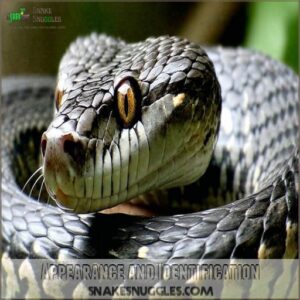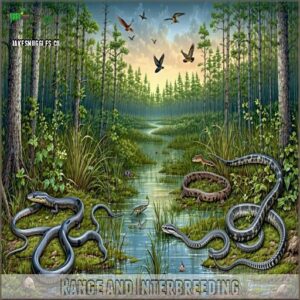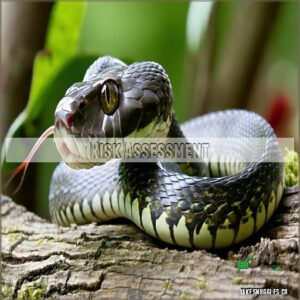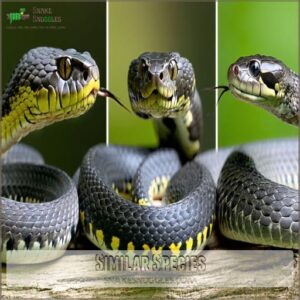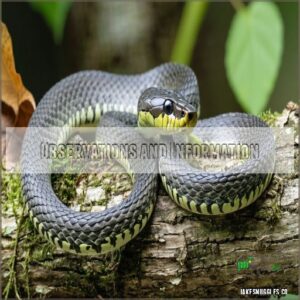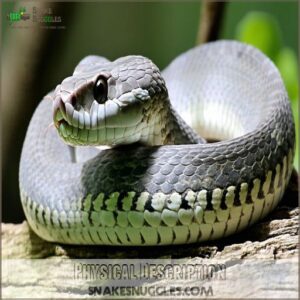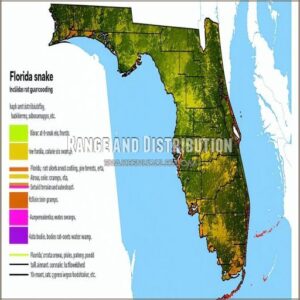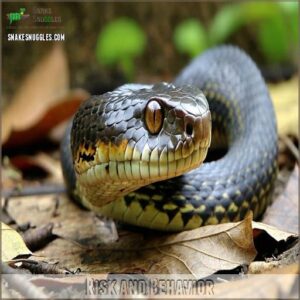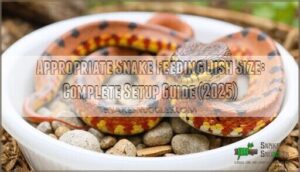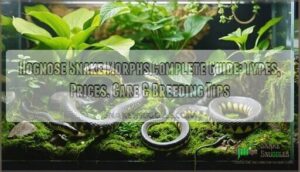This site is supported by our readers. We may earn a commission, at no cost to you, if you purchase through links.
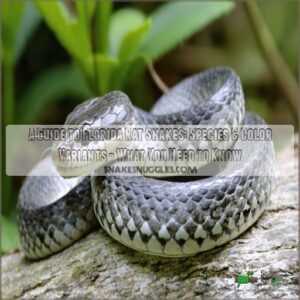 You’ll find two main rat snake species in Florida: the Eastern and Gray ratsnakes.
You’ll find two main rat snake species in Florida: the Eastern and Gray ratsnakes.
The Eastern variety, stretching 3.5 to 7 feet long, shows off a glossy black to yellow coat with distinctive white chin markings. They’re common throughout the peninsula and eastern panhandle.
Their cousins, the Gray ratsnakes, rule the western panhandle, sporting a pale gray look with darker blotches and reaching impressive lengths up to 84 inches.
Both species help keep rodent populations in check and are completely harmless to humans, though they might surprise you with their defensive tail-shaking dance – nature’s version of a bluff.
Table Of Contents
- Key Takeaways
- Eastern Ratsnakes in Florida
- Gray Ratsnakes in Florida
- Frequently Asked Questions (FAQs)
- What color are the rats snakes in Florida?
- Are rat snakes different colors?
- What is the multi colored snake in Florida?
- What rat snakes for beginners?
- What is the colorful snake in Florida?
- How do you identify a GREY rat snake?
- How do you identify rat snakes in Florida?
- Are there rat snakes in Florida?
- How big does a red rat snake grow in Florida?
- Are red rat snakes endangered in Florida?
- Conclusion
Key Takeaways
- You’ll find two main rat snake species in Florida: Eastern ratsnakes (black to yellow, 3.5–7 feet long) in the peninsula and eastern panhandle, and Gray ratsnakes (pale gray with darker blotches, up to 84 inches) in the western panhandle.
- Both species are completely harmless to humans and help control rodent populations naturally, though they may display defensive behaviors like tail-shaking when cornered.
- You can identify Eastern ratsnakes by their white chin markings and smooth scales in 21–25 dorsal rows, while Gray ratsnakes feature a distinctive light gray mask and similar scale patterns.
- When their territories meet near the Apalachicola River, Eastern and Gray ratsnakes interbreed, creating unique hybrid populations that enhance genetic diversity.
Eastern Ratsnakes in Florida
You’ll find Eastern Ratsnakes throughout Florida except in the western panhandle.
where they display an impressive variety of colors from glossy black to yellow with striking white splotches.
Whether you spot one climbing a tree or swimming across a pond, you can identify these helpful creatures by their substantial size of 3.5 to 7 feet and distinctive white chin and throat markings.
Appearance and Identification
You’ll spot Eastern Ratsnakes in Florida sporting a stunning wardrobe of colors, from sunny yellow to earthy tan.
These adaptable serpents catch your eye with their smooth, glossy scales arranged in 21-25 dorsal rows.
Keep an eye out for their distinctive rounded snout and dark eyes that blend seamlessly with their scales.
Young ones rock a gray base with bold dark blotches, while adults show off sleek longitudinal stripes.
Range and Interbreeding
Let’s explore where Eastern Ratsnakes call home in Florida. These adaptable snakes thrive throughout the peninsula and eastern Panhandle, stretching down to Key Largo.
When their territory meets Gray Ratsnakes west of the Apalachicola River, something fascinating happens – they interbreed, creating unique hybrid populations.
This natural mixing enhances genetic diversity and helps both species adapt to Florida’s varied habitats.
Risk Assessment
Despite their impressive size, Eastern Ratsnakes in Florida are completely harmless to humans and pets.
These non-venomous snakes prefer flight over fight, using defensive displays like tail vibration and musk release when cornered.
For peaceful coexistence, simply give them space, seal home entry points, remove potential nesting areas, and educate yourself on proper identification.
Remember, these beneficial predators help control rodent populations naturally.
Similar Species
Among Florida’s rat snake varieties, several similar species can create identification challenges. This phenomenon has even led to the creation of rat snake look alikes in products such as toys and replicas rat snake look alikes.
The Red Cornsnake stands out with its distinctive brownish-red coloring and checkerboard belly pattern.
Gray Ratsnakes often resemble juvenile Eastern Ratsnakes, while Scarlet Kingsnakes display coral snake mimicry with red-black-yellow bands.
For safety reasons, it’s important to remember that Eastern Diamondback Rattlesnakes share some habitat overlap but are venomous and easily identified by their rattler.
Observations and Information
Your observations of Florida rat snakes make a real difference in research and conservation.
When you spot one, take quick notes about its colors and patterns, then share them on iNaturalist.
The Florida Museum’s herpetology team uses this citizen science data to track population changes and color variants.
Whether it’s a juvenile Eastern Ratsnake or an adult Gray Ratsnake, every sighting counts.
Gray Ratsnakes in Florida
You’ll find these impressive gray-scaled hunters in Florida’s western panhandle, where they can grow up to an impressive 84 inches long.
If you spot a pale gray snake with darker blotches climbing through pine forests or marshlands,
you’re likely looking at a Gray Ratsnake, also known locally as the White Oak Snake.
Physical Description
Gray Ratsnakes showcase distinctive features that make them stand out in Florida’s snake population.
Their size, typically ranging from 42 to 72 inches, is a key characteristic as detailed in this detailed guide.
You’ll notice their striking light gray base color adorned with darker blotches, a pattern that’s especially vibrant in juveniles.
Their scales tell a precise story: 21-25 rows along the back and 160-174 on the belly.
The head sports an elegant light gray mask, while dark bands stretch from the eyes.
Range and Distribution
The western Florida Panhandle serves as home base for these adaptable serpents, with their territory extending west of the Apalachicola River.
You’ll notice them thriving in diverse settings, from cypress strands to pine forests.
They can be found in various products related to their Florida gray ratsnake range.
Their distribution patterns tell an interesting story, showing clear preferences for specific habitats and seasonal movements.
In areas near the river, they’ve been known to interbreed with their Eastern Ratsnake cousins.
Risk and Behavior
Living alongside Florida’s Gray Ratsnakes is remarkably straightforward, as these non-venomous serpents prioritize peace over confrontation.
When startled, they’ll showcase defensive behaviors like tail vibration or striking poses – nature’s way of saying "please give me space."
While bites are extremely rare, they can happen if the snake feels cornered.
Your best strategy? Simply back away slowly and let these helpful rodent-controllers go about their business.
Frequently Asked Questions (FAQs)
What color are the rats snakes in Florida?
Florida’s diverse rat snake population showcases remarkable variety.
You’ll find Eastern rat snakes in glossy black with white spots.
Gray rat snakes are pale gray with darker blotches.
Corn snakes sport orange-red patterns with distinctive saddles.
Are rat snakes different colors?
Yes, you’ll find rat snakes in stunning variety.
From glossy black Eastern rat snakes and light gray "White Oak" snakes to orange-red Corn snakes.
Some even show unique patterns like yellow stripes or dark blotches.
What is the multi colored snake in Florida?
Ever spotted a snake that seems to change colors?
You’ll find the Corn Snake in Florida with its stunning orange base and red blotches.
It’s part of the rat snake family and completely harmless.
What rat snakes for beginners?
Corn snakes make perfect starter pets because they’re docile and easy to handle.
They stay relatively small (3-4 feet).
They have simple care requirements, and you’ll find them widely available in various beautiful colors.
What is the colorful snake in Florida?
Like a sunset painted on scales, you’ll find the most vibrant Florida serpent is the Corn Snake (Pantherophis guttatus).
It sports striking orange-red saddles on a light orange background, with some showing gray or rosy variations.
How do you identify a GREY rat snake?
You’ll spot a Grey rat snake by its pale gray body with darker gray blotches and tan-gray belly.
They’re typically 42-72 inches long and have a distinctive light facial mask with 21-25 dorsal scale rows.
How do you identify rat snakes in Florida?
Just as each star has its own pattern, Florida’s rat snakes reveal their identity through distinct traits.
Eastern snakes show black or yellow scales.
Gray snakes display light patterns.
Corn snakes sport orange-red blotches.
Are there rat snakes in Florida?
Yes, Florida’s home to three distinctive rat snake species: the Eastern Rat Snake, Gray Rat Snake, and Corn Snake.
They’re non-venomous, helpful for pest control, and can be found throughout different regions of the state.
How big does a red rat snake grow in Florida?
Red rat snakes, commonly known as corn snakes in Florida, reach impressive lengths of 30-48 inches.
Some exceptional specimens grow up to 72 inches.
In the Florida Keys, you’ll find slightly smaller specimens.
Are red rat snakes endangered in Florida?
Corn snakes (also known as red rat snakes) aren’t endangered in Florida.
They’re actually thriving throughout the state.
Though they face some challenges from habitat loss, vehicle collisions, and occasional human collection.
Conclusion
Like guardians of Florida’s natural balance, rat snakes silently patrol our yards and wild spaces.
When you spot these remarkable reptiles, you’re witnessing living examples of Florida’s rich biodiversity.
This guide to Florida rat snake species and color variants helps you identify and appreciate these beneficial creatures.
Whether it’s the Eastern’s glossy sheen or the Gray’s subtle patterns, these snakes deserve our respect and protection as they help maintain our ecosystem’s delicate harmony.

